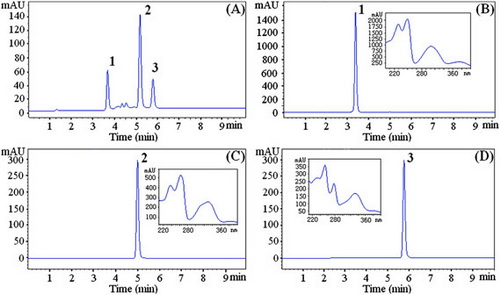Xanthones, the primary constituents of Swertia mussotii, are known to possess a variety of biological activities, including antidepressant, antileukaemic, antitumor, antitubercular, choleretic, diuretic, antimicrobial, antifungal, anti-inflammatory, antiviral, cardiotonic and hypoglycemic properties. However, high performance, environmentally friendly methods for isolating and purifying xanthones from S. mussotii are not currently available.
To develop a high performance and environmentally, friendly method for the preparative separation of xanthones methylswertianin, swerchirin and decussatin from S. mussotii using high-speed counter-current chromatography (HSCCC).
A solvent system composed of n-hexane–ethyl acetate–methanol –water (5:5:10:4, v/v/v/v) was developed for the separation method. The upper phase was used as the stationary phase, and the lower phase was used as the mobile phase at a flow rate of 1.5 mL/min, a rotation speed of 800 r/min, and a temperature of 25 °C.By this means, 8 mg of methylswertianin, 21 mg of swerchirin and 11 mg of decussatin with purities of over 98% could be isolated from a 150 mg crude sample. Then, they were identified by 1H NMR and 13C NMR analysis. Finally, three xanthones in Swertia mussotii could be systematically isolated and purified using HSCCC.

Figure. (A) HPLC chromatogram of the crude sample from Swertia mussotii
and (B–D) HPLC chromatograms and UV spectra of compounds 1–3.
Column: Eclipse XDB C18-column (150mm 4.6mm i.d., 5um);
mobile phase: methanol and water in gradient mode (methanol concentration raised
from 80% to 85% in the beginning 2.5 min and increased to 95% within the following 6.5 min);
flow rate: 1.0 mL/min; column temperature: 25 C; UV wavelength: 254 nm.
Additional Information:
1 Author Information: Jing Jia, Tao Chen, Ping Wang, Guichen Chen, Jinmao You, Yongjun Liu and Yulin Li.
Correspondence: E-mail: Yulin Li (liyulin@nwipb.cas.cn)
2 Published:
Phytochemical Analysis, Volume 23, Issue 4, pages 332–336, July/August 2012
Issue published online: 21 JUN 2012
